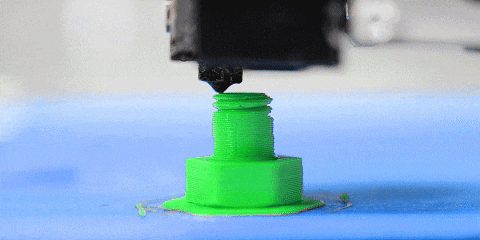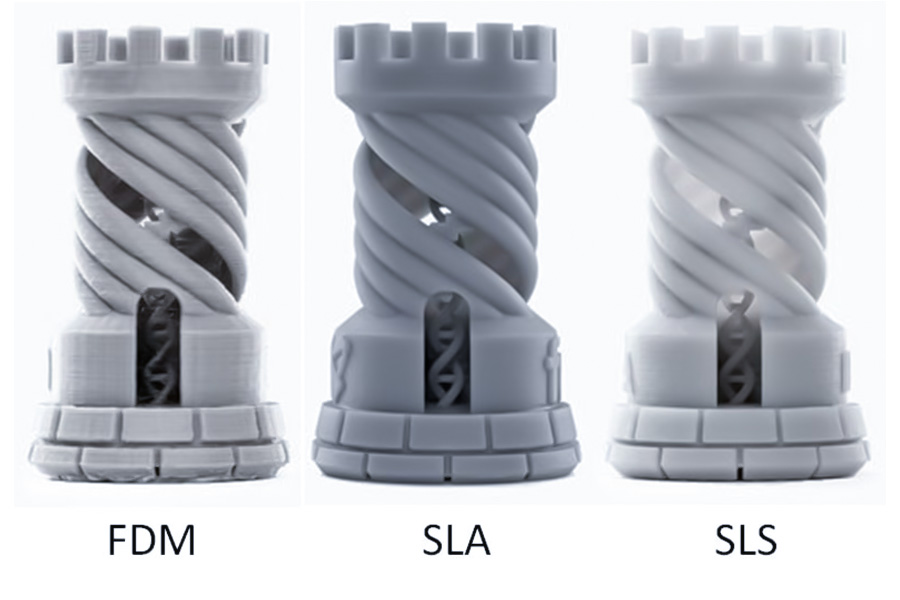3D印刷は、デジタルモデルを介して素材をオーバーレイし、仮想設計を実際のオブジェクトに直接変換し、従来の製造業の金型と切断技術への依存の制限を完全に覆します。このテクノロジーは複雑な幾何学的構造を作成できるだけでなく、 3D印刷サービスの柔軟なエコシステムを通じて市場需要に迅速に対応できるようになります。 href = "https://jsrpm.com/industry/medical-device">建設業界全体の迅速なプロトタイピングの医療業界でのインプラント生産。
3D印刷は、その効率と低消費で世界の製造環境を再構築しています。設計ドキュメントをアップロードすることにより、スタートアップまたは業界の巨人が新興企業であろうと、JS企業は、想像力のあるアイデアを print ing service 
3D印刷とは?
3dprintingは、デジタルモデルを介して材料を階層化してエンティティを直接製造し、金型やテクニックを切断する従来の製造パターンに革命をもたらす技術です。 カスタマイズされたコンポーネントを迅速に生産できるようになり、開発コストと時間を大幅に削減できます。 航空宇宙産業では、幾何学的制約、複雑な内部構造を作成する、中空構造、さらには生体模倣形態を作成し、イノベーションの可能性を大幅に解放します。
3D印刷技術が最初に開発された
3D印刷href = "https://jsrpm.com/rapid-prototyping"> 1980年代の迅速なプロトタイピングで、当初航空宇宙、自動車製造、ヘルスケアなどの高精度産業にソリューションを提供しました。
- aerospace:軽量チタン合金のプロトタイプの製造に使用されます
- Medical Field: 自動開発:高速繰り返しコンポーネントプロトタイプ(Intakeマニフォルズなど)。
Data-TranslateID = "CD3209876BB937562F771714BBDB388E" data-pos = "0" data-len = "36" data-v-7b79c893 = ""> コスト
- 初期装置、ステレオリソグラフィ(SLA)または選択的レーザー焼結(SLS)テクノロジーを使用して、数百万ドル以上のコストがかかり、大企業または研究施設についてのみ手頃な価格でした。
- 材料は、感光樹脂や金属粉末などの高価な材料に限定されており、印刷の精度はデバイス解像度によって制限されます(初期の±0.1mm)。
- プロのエンジニアへの依存により、平均的なユーザーが到達することが困難になります。
- 材料は、感光樹脂や金属粉末などの高価な材料に限定されており、印刷の精度はデバイス解像度によって制限されます(初期の±0.1mm)。
- desktop fdmプリンター ultimakerや創造性などは、数千ドルになり、個々のファーミーモデルを印刷するために個々の親愛者を印刷するために数千ドルになりました。装飾。
- オープンソースコミュニティはイノベーションを促進し、ユーザーがThingiverseなどのオンラインプラットフォームを介して3D印刷モデルをダウンロードし、自分自身を変更して印刷できるようにします。
消費者グレードのデバイスは、PLA、ABS、PETGなどの安価な素材をサポートしています。一部のハイエンド製品は、木材およびセラミックコンポジット消耗品と互換性があります。
data-TranslateID = "8A3274B57B4BA49DD6C6CF5B6C49B8E0" DATA-POS = "0" DATA-LEN = "44"データ-V-7B79C893 = ""> 初期には、産業レベルのサービスは企業クライアントのみが利用できました。 3D-printingモデルオンラインプラットフォームを介して、より低いコストで専門の工場から委託します。
design datign datign datign datign Digital Models SolidworksなどのCADソフトウェアを使用して3Dモデルを作成するか、Thingiverseなどのオンラインプラットフォームから既製の3D印刷モデルをダウンロードします。
モデルをスライシングソフトウェア(curaなど)にインポートし、印刷パラメーター(層の高さ、充填密度、サポート構造など)を設定します。 G-Codeコマンドファイルは、プリンターが認識できることです。 3Dモデルファイルをプロの3D印刷プラットフォームまたは contact comet your comet your compider ワンストップソリューションを提供する、適切な材料(例えば、エンジニアリングプラスチック、金属合金、感光樹脂など)のインテリジェントな推奨事項に基づいて、最適な成形プロセス(FDM、SLAなどの主要なテクノロジーなど)
4.precision印刷段階 産業用グレードの機器で階層化されたサービスプロバイダー: 印刷製品は、自動化されたサポート、マニュアル仕上げ(磨き/噴霧)、品質検査、その他のプロセスを通じてグローバルな物流分布またはローカルセルフコレクションをサポートします。 送達サイクルと完成品の状態が透明で制御可能であることを確認してください。 インクジェット印刷および3D印刷の組み合わせは、主にインクジェット印刷によって達成されます。コアでは、液体材料(樹脂、セラミックパルプ、導電性インクなど)を噴霧し、層ごとに固化した層で固めて、マイクロメートルレベルのノズルによって3次元構造を形成します。特定の組み合わせには、 1.マテリアルダイレクトライティングモールディング: インクジェット印刷技術を使用して、高粘度材料を正確に噴霧し、複雑な幾何学的な形状に層状に層状にします。 href = "https://jsrpm.com/contact-us">小さなバッチカスタマイズ。 2.機能的な表面製造:基板表面上のスプレー機能インク(導電性シルバーペースト、バイオインクなど)は、電子回路または組織足場を直接構築します。 3.Multi Material Hybrid Printing: sto 異なる印刷技術の層の厚さは、最終的な表面の粗さと強度にどのように影響しますか?
表面粗さ 17px; "> 1.表面粗さに対する層の厚さの影響 fdm vs sla: sls: 2。 data-translateID = "1304AF32795E646507A2C444731FF1AA6" data-pos = "3" data-len = "55" data-v-7b79c893 = ""> 層の厚さは、表面の品質に影響するだけでなく、間接的に層間結合強度と内部欠陥を介して部品の軸受能力を決定します。
<テーブルスタイル= "境界線 - 崩壊:崩壊;幅:100%;境界線幅:1px;境界線:#000000; height:211.859px;" border = "1"> 実験データ fdm(pla material): sla(樹脂材料): sls(ナイロン素材): 簡単な概要 precision要件(例えば、ジュエリー、医療モデル)
高強度要件(機能部品など):SLSまたはFDMの平衡層(0.1-0.2mm)の厚さを選択します。
迅速な成形:fdmは層の厚さを増加させる可能性があります(0.2-0.3mm)
1.Customization The digital modeling and layered superposition characteristic of 3D printing enables complex geometric shapes to be manufactured without mould or large upfront investment, completely satisfying the need for individualization. Technical support: Case in point: JS uses SLA technology to assist dental clinics print personalized orthodontic appliances based on patient dental data. 2.Sustainability of 3D Printing 3D printing consumes only the materials needed and reduces waste generation compared to traditional subtractive manufacturing, such as cutting, and is therefore particularly suitable for expensive materials such as titanium alloys and carbon fiber composites. Data comparison: Case in point: JS provides lightweight structural components for drone manufacturers with 50% increase in material utilization. 3.Speed advantage 3D printing eliminates need for mold development and multi-process coordination, greatly shortens the product development cycle, and is especially suitable for rapid prototyping and small batch production. Technology efficiency comparison: Unlike traditional printing shops, JS offers differentiated solutions with industrial-grade equipment and expertise: 1.Ultra-high precision and complex structure Support ±0.005mm tolerances, well above industry standards, for manufacturing precision parts (e.g. medical devices, aerospaceコンポーネントなど)。 Dealing with complex geometric shapes without pressure, hollow structures, irregular surfaces and other designs can be achieved without the need for molds. 2.Material diversity We offer more than 50 material options covering metals (aluminum, titanium, stainless steel), engineering plastics (PEEK), biocompatible materials, and more to meet the needs of automotive, electronics, and healthcare industries. 3.Efficient production and quick delivery 4.Cost optimization 5.Sustainable manufacturing By using environmentally friendly materials and energy-efficient equipment, carbon emissions reduced by 15% and waste recycling rate up to 20%, in line with the trend towards green manufacturing. 3D printing redefines manufacturing possibilities by converting digital models into physical objects. Whether through layered stacking by FDM, precise solidification by SLA, or powdery fusion by SLS, 3D printing has been driving industries to break through traditional limitations with its agile design, high resource utilization, and fast iteration. With the help of 3D printing service, the manufacture of complex structures is within reach, from personalized medical implants to rapid prototyping of lightweight aerospace components. As technology spreads and service ecology improves, 3D printing not only lowers the innovation threshold, but also shifts customization production from niche needs to large-scale applications. The content of this page is for informational purposes only.JS SeriesNo representations or warranties of any kind, express or implied, are made as to the accuracy, completeness or validity of the information. It should not be inferred that the performance parameters, geometric tolerances, specific design features,material quality and type or workmanship that the third-party supplier or manufacturer will provide through the jusheng network. This is the responsibility of the buyerAsk for a quote for partsto determine the specific requirements for these parts.please Contact us Learn more information. JS is an industry-leading companyFocus on custom manufacturing solutions. With over 20 years of experience serving more than 5,000 customers,we focus on high precisionCNC machining,Sheet metal fabrication,3D printing,Injection molding,metal stamping,and other one-stop manufacturing services. 1.Why do some 3D printed models require support structures? In 3D printing, if the model has a suspension or a tilt angle too high (for example, more than 45°), the material can easily collapse under gravity as it piles on top of each other. The supporting structure serves as a temporary framework to support the suspension section, ensuring accuracy and completeness of printing. 2.Why is industrial-grade printing more expensive than desktop printing? The high cost of industrial printing is due to higher requirements for materials such as titanium alloys and engineering plastics, maintenance of precision equipment such as laser calibration and high temperature systems, and technical support costs. At the same time, high accuracy, stability and mass production efficiency must be ensured, while desktop printing focuses on low cost and ease of use. 3.What's the difference between metal 3D printing and plastic printing? Metal printing requires high-temperature molten powder (such as SLS), which makes the the finished product stronger, but the equipment is expensive and mainly used in high-end areas such as aerospace and medical implants. Plastic printing is formed by molten deposition or photosynthesis. It is low-cost, simple to operate, suitable for prototypes and everyday products, and lightweight and economical. 4.What are the key steps in 3D printing reprocessing? Post-processing for 3D printing involves removal of support structures, surface polishing to remove layer marks, heat treatment to enhance strength, and beautification steps such as surface spraying or polishing to ensure the the finished product is smooth, durable, and meets design requirements. 単純に言えば、3D印刷はどのように機能しますか?

インクジェットと3D印刷を組み合わせる方法
表面粗さ(RA値)は、主に層間ステップ効果によって決定されます。層の厚さが小さくなるほど、ステップは明白ではなく、表面が滑らかになります。
テクニック
典型的な層の厚さ範囲
表面粗さ(ra)の比較
fdm
0.1–0.4 mm
fdm 0.1mm層の厚さ:ra≈15–30μm
sla
25–100μm
sla25μm層の厚さ:ra≈2–5μm
SLS
0.05–0.3 mm
SLS 0.1mm層の厚さ:RA≈10〜20μm
テクニック
層の厚さと強度の関係
fdm
層の厚さの増加(例:0.4mm)→層間結合力の減少→引張強度の減少は約30%。 >
sla
層の厚さを減らす(例:25μm〜50μm)→残留応力を減らす→曲げ強度を15-20%増加します。 >
sls
薄い層の厚さ(<0.1mm)→粉末の不完全な焼結→多孔度の増加→強度の減少。

3D印刷を使用する理由
Technique
Prototype production time (complex gearbox)
該当するシナリオ
Traditional Casting
2-4 weeks (including mold making)
Large number, standard pieces.
FDM
12-24 hours
Rapid validation of design feasibility.
SLA
6-8 hours (high precision)
Functional prototypes, transparent components.
What are the advantages of JS's 3D printing technology?
Summary
Disclaimer
JS Team
Our factory is equipped with more than 100 state-of-the-art 5-axis machining centers and is ISO 9001:2015 certified. We provide fast, efficient and high-quality manufacturing solutions to customers in more than 150 countries around the world. Whether it's low-volume production or mass customization, we can meet your needs with the fastest delivery within 24 hours. chooseJS TechnologyIt means choosing efficiency, quality and professionalism.
To learn more, please visit our website:jsrpm.comFAQs
Resources






